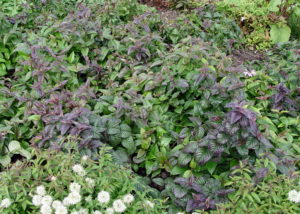Eastern Beebalm
* Common name: Eastern beebalm 
* Botanical name: Monarda bradburiana
* What it is: A midwestern prairie native that produces tubular pinkish-white flowers in May and June and then has foliage that turns burgundy in fall.
Sometimes called Bradbury’s beebalm, eastern beebalm is a mint-family plant with mint-smelling leaves and a spreading although not overly aggressive habit.
It’s one of the most mildew-resistant types of beebalm and seldom runs into any bug or animal issues, including deer, which don’t like it.
It’s attractive to bees, hummingbirds, and other pollinators, though, and is widely planted in Penn State Arboretum’s Pollinator and Bird Garden, if you want to see it in action.
* Size: Plants grow about one foot tall, sometimes up to two feet including flower spikes. Space two feet apart. As with most beebalms, plants colonize quickly. Can also multiply by self-seeding.
* Where to use: Full sun to light shade. Eastern beebalm tolerates fairly poor soil and drought, although it’ll also do reasonably well in damp soil.
Good locations include meadows, pollinator gardens, rain gardens, cottage gardens, and on semi-shaded slopes.
* Care: Water in very dry spells. Fertilizer usually not needed.
Flower spikes can be cut off after bloom and any floppy growth also can be shortened during summer. Plants can be cut completely to the ground in late fall or any time before early spring after the leaves brown.
Clumps can be dug, divided, and replanted in early spring if they’re becoming crowded or spreading where you don’t want.
* Great partners: Prairie dropseed is a good native-grass partner that pairs nicely both texturally and in fall color. Purple coneflowers, liatris, and penstemon are other good native-perennial partners.







